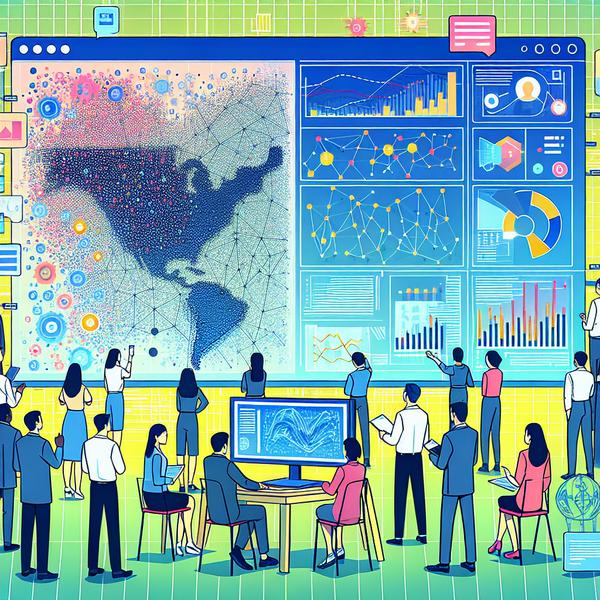
Have you ever wondered how artificial intelligence could model and simulate the complexities of human societies? Enter AgentSociety: a groundbreaking open-source framework that empowers massive simulations of agents, each driven by Large Language Models (LLMs). It combines cutting-edge technologies like Ray distributed processing to enable simulations of over 30,000 agents in realistic settings. From social media behaviors to urban planning scenarios, this framework creates a virtual playground for studying societal interactions with unprecedented realism, speed, and scale.
Exploring the Real-World Applications of AgentSociety
- AgentSociety makes studying societal dynamics more accessible and accurate by creating human-like agent simulations. Imagine researchers using it to replicate population behavior during a public health crisis—such simulations could predict the spread of information or misinformation.
- Its utility extends far beyond research. For instance, urban planners can simulate traffic patterns in a virtual city, identify potential bottlenecks, and optimize infrastructure development in real life based on data-driven projections.
- Moreover, policymakers can test different policy interventions in a controlled virtual setup before implementing them in the real world. This method saves resources while ensuring efficient decision-making.
- Social scientists, too, can explore phenomena such as how societal norms evolve or how online communities form and dissolve, thanks to the framework's capabilities to mimic both virtual and physical spaces.
- In short, AgentSociety’s impressive realism makes the theoretical study of society more practical and impactful than ever before!
How AgentSociety Achieves Its Massive Scale
- If you think simulating 30,000 agents sounds slow, think again! AgentSociety operates faster than real time, thanks to its use of the Ray framework for parallel computing. It organizes agents into groups called "actors," optimizing resource use.
- Think of Ray like a super-efficient air traffic controller, ensuring that thousands of agents interact without slowing down. The system makes asynchronous network requests and reuses connections, reducing bottlenecks while boosting scalability.
- On a setup with 24 NVIDIA A800 GPUs, simulations of entire societies are not just fast but incredibly smooth, even with high computational workloads.
- Performance scales linearly, meaning that adding more GPUs or resources significantly increases the simulation speed—an engineer’s dream for any large-scale system!
- Ready for big numbers? In the most extensive test, AgentSociety simulated 30,000 agents completing tasks faster than the real-world elapsed time. It’s like watching a complex scenario unfold at fast-forward speed!
Building a Realistic Society: The Three Key Spaces
- To make agents act more like humans, AgentSociety integrates three essential environments: urban, social, and economic spaces. Think of these as the stage, props, and scripts for a play.
- In the urban space, the framework uses real-world map data, like road networks and points of interest, to simulate navigating a city by foot, car, or public transport. A fun example? Imagine agents deciding between taking a scenic but slow walk or hopping on a nearby bus during rush hour.
- The social space focuses on relationships. Agents form evolving social networks and even simulate online interactions like blocking, messaging, or moderating comments—perfect for studying social media dynamics.
- Then there’s the economic space, where agents manage jobs, pay taxes, spend money, and interact with banking systems, all driven by decisions-oriented AI. This approach mirrors real-world economic scenarios, helping identify better solutions for financial policies.
- These combined environments create a level of authenticity that makes simulations surprisingly relatable—almost as if you were observing a miniature world with lifelike communities.
Technology Behind AgentSociety’s Dynamic Architecture
- AgentSociety’s brilliance lies in its flexible yet powerful tech stack, which handles the heavy lifting seamlessly. Each agent communicates through Redis’ Pub/Sub feature, ensuring efficient real-time messaging between thousands of agents.
- With the Time Alignment Mechanism, agents stay in sync with their dynamic environments, even if some LLM API calls take extra processing time. Think of it like a perfectly choreographed dance where everyone stays on beat, no matter the tempo shifts!
- The system logs and tracks everything—it uses PostgreSQL, local storage, and tools like MLflow to record data. This is gold for researchers who want to analyze what worked and what didn’t.
- AgentSociety even includes a GUI for easy experiment management. Forget coding expertise; anyone can now explore complex societal questions by tweaking settings on a user-friendly interface.
- Thanks to this, developers and researchers can focus on the "what ifs" instead of worrying about the technical "hows"—making it a revolutionary leap in simulation software.
Empowering Solutions Across Industries
- AgentSociety isn’t just for academics; its adaptable framework opens doors for almost every industry. For example, disaster management teams could simulate evacuations under different emergency scenarios to save lives and optimize logistics.
- Corporate leaders, too, can use it to model workforce dynamics. Imagine simulating how employee satisfaction changes with different organizational policies—quick insights, less HR headaches!
- Public sector applications are equally exciting. Governments can use the platform to evaluate the impact of renewable energy policies, tracking how households adopt green technologies.
- Marketers could analyze consumer behaviors in a simulated retail space, sharpening ad campaigns while reducing real-world misses. It’s like having a predictive test market without the risk!
- The flexibility of AgentSociety ensures that businesses, governments, and NGOs alike can shape its tools to fit their unique challenges—empowering better decisions every step of the way.